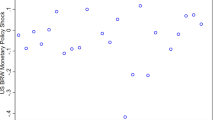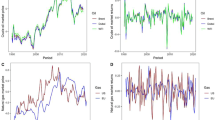Abstract
Relying on a cost-push input-output model for China, we estimate the exchange rate pass-through to both domestic prices and export prices at the industry level. Our empirical results indicate that the decline of the RMB price in the processing exports sector in response to an RMB appreciation is larger than that in the non-processing exports sector, which, in turn, is larger than the decline of the consumer price indexes. Our cross-sector analysis also suggests that exchange rate changes have the lowest impact on prices in capital- and technology-insensitive industries.
Similar content being viewed by others
Notes
Processing exports include: 1) Processing with Imported Materials (PIM): the business enterprise in China makes a foreign exchange payment for imported raw and auxiliary materials, parts and components, accessories, and then exports the finished products after processing or assembly. 2) Processing & Assembling (P&A): the business enterprise does not have to make a foreign exchange payment for the imports, but just charges the foreign party a processing fee.
Pei et al. (2012) observe that the contribution of the change in exports to the change in value added in China (from 2002 to 2007) was 32% higher when ordinary IO tables are used than when the tables capturing processing trade are used. On a similar note, Craighead (2020) argues that intermediate goods trade reduces the “exchange rate disconnect” by increasing the volatility of the real exchange rate relative to output and weakening the link between the real exchange rate and output.
A few previous studies have shown the importance of imported intermediate inputs for ERPT. For example, Shi and Xu (2010) find that the degree of ERPT to intermediate import prices affects the economy more than the ERPT to final import prices. However, most previous studies ignored the price transmission through imported intermediate goods and production chains at the industry level. Furthermore, previous studies neglected processing trade, which accounts for about two thirds of total Chinese trade (Johnson and Noguera 2012).
Some previous studies used IO models to analyze price formation (Folloni and Miglierina 1994). Some studies research the impact of changes in energy prices (Berüment and Taşçı 2002; Bazzazan and Batey 2003; Wu et al. 2013), while others focus on the effect of implicit subsidies on sectoral prices (e.g. Sharify 2013).
See Carvalho (2014) for a literature review.
The data are available at http://www.oecd.org.
It is worth stressing that except for the production network, an exchange rate appreciation can also influence domestic and export prices through other channels, such as firms’ markups or product quality. However, these other channels are not focused upon in our analysis.
More specifically, the processing exports of each industry are used as weights to calculate the ERPT for total processing exports, while the non-processing exports are used for that of non-processing exports, and the outputs for domestic demand are used for that of domestic demand.
References
Acemoglu D, Akcigit U, Kerr W (2015) Networks and the macroeconomy: an empirical exploration. NBER Macroecon Annu 30(1):273–335
Aydoğuş O, Değer C, Çalışkan ET, Günal GG (2018) An input-output model of exchange-rate pass-through. Econ Syst Res 30(3):323–336
Barhoumi K (2006) Differences in long run exchange rate pass-through into import prices in developing countries: an empirical investigation. Econ Model 23(6):926–951
Bazzazan F, Batey P (2003) The development and empirical testing of extended input–output price models. Econ Syst Res 15:69–86
Bergin PR, Feenstra RC (2009) Pass-through of exchange rates and competition between floaters and fixers. J Money Credit Bank 41(1):35–70
Berüment H, Taşçı H (2002) Inflationary effect of crude oil prices in Turkey. Physica A 316:568–580
Betts C, Devereux MB (2000) Exchange rate dynamics in a model of pricing-to-market. J Int Econ 50(1):215–244
Bigio S, La’O J (2016) Distortions in production networks. NBER Working Paper 22212
Bouvet F, Ma AC, Van Assche A (2017) Tariff and exchange rate pass-through for Chinese exports: a firm level analysis across customs regimes. China Econ Rev 46:87–96
Bussière M (2013) Exchange rate pass-through to trade prices: the role of nonlinearities and asymmetries. Oxf Bull Econ Stat 75(5):731–758
Bussière M, Chiaie SD, Peltonen TA (2014) Exchange rate pass-through in the global economy: the role of emerging market economies. IMF Econ Rev 62(1):146–178
Bussière M, Gaulier G, Steingress W (2020) Global trade flows: revisiting the exchange rate elasticities. Open Econ Rev 31(1):25–78
Campa JM, Goldberg LS (2002). Exchange rate pass-through into import prices: a macro or micro phenomenon? NBER Working paper no. 8934
Campa JM, Goldberg LS (2005) Exchange rate pass-through into import prices. Rev Econ Stat 87:679–690
Carvalho VM (2014) From micro to macro via production networks. J Econ Perspect 28(4):23–48
Chen X, Cheng LK, Fung KC, Lau LJ, Sung YW, Zhu K, Yang C, Pei J, Duan Y (2012) Domestic value added and employment generated by Chinese exports: a quantitative estimation. China Econ Rev 23:850–864
Cheung Y, Steinkamp S, Westermann F (2020) A tale of two surplus countries: China and Germany. Open Econ Rev 31(1):131–158
Choudhri EU, Hakura DS (2006) Exchange rate pass-through to domestic prices: does the inflationary environment matter? J Int Money Financ 25:614–639
Choudhri EU, Faruqee H, Hakura DS (2005) Explaining the exchange rate pass-through in different prices. J Int Econ 65(2):349–374
Craighead WD (2020) Intermediate goods and exchange rate disconnect. Open Econ Rev 31(1):113–129
Devereux MB, Dong W, Tomlin B (2017) Importers and exporters in exchange rate pass-through and currency invoicing. J Int Econ 105:187–204
Dixit A (1989) Hysteresis, import penetration, and exchange rate pass-through. Q J Econ 104(2):205–228
Enders A, Enders Z, Hoffmann M (2018) International financial market integration, asset compositions, and the falling exchange rate pass-through. J Int Econ 110:151–175
Fisher E (1989) A model of exchange rate pass-through. J Int Econ 26(1–2):119–137
Folloni G, Miglierina C (1994) Hypothesis of price formation in input–output tables. Econ Syst Res 6:249–264
Frankel J, Parsley D, Wei S-J (2012) Slow pass-through around the world: a new import for developing countries? Open Econ Rev 23(2):213–251
Froot KA, Klemperer PD (1989) Exchange rate pass-through when market share matters. Am Econ Rev 79(4):637–654
Gopinath G, Itskhoki O, Rigobon R (2010) Currency choice and exchange rate pass-through. Am Econ Rev 100(1):304–336
Johnson RC, Noguera G (2012) Accounting for intermediates: production sharing and trade in value added. J Int Econ 86(2):224–236
Li Y, Zhang T (2018) Incomplete exchange rate pass-through: evidence from exchange rate reform in China. Emerg Mark Financ Trade 54:690–706
Li YA, Zhao CC (2016) Price adjustment to exchange rates and forward-looking exporters: evidence from USA–China trade. Rev Int Econ 24(5):1023–1049
Li H, Ma H, Xu Y (2015) How do exchange rate movements affect Chinese exports? A firm-level investigation. J Int Econ 97(1):148–161
López-Villavicencio A, Mignon V (2017) Exchange rate pass-through in emerging countries: do the inflation environment, monetary policy regime and central bank behavior matter? J Int Money Financ 79:20–38
Marazzi M, Sheets N (2007) Declining exchange rate pass-through to U.S. import prices: The potential role of global factors. J Int Money Financ 26:924–947
Pei J, Oosterhaven J, Dietzenbacher E (2012) How much do exports contribute to China's income growth? Econ Syst Res 24:275–297
Razafindrabe T (2017) Nonlinearity and asymmetry in the exchange rate pass-through: what role for nominal price stickiness? Rev Int Econ 25(4):711–732
Sharify N (2013) Input–output modelling of the effect of implicit subsidies on prices. Econ Model 33:913–917
Shi K, Xu J (2010) Intermediate goods trade and exchange rate pass-through. J Macroecon 32(2):571–583
Shu C, Su X (2009) Exchange rate pass-through in China. China World Econ 17(1):33–46
Taylor JB (2000) Low inflation pass-through and the pricing power of firms. Eur Econ Rev 44:1389–1408
Wu L, Li J, Zhang Z (2013) Inflationary effects of oil-price shocks in an imperfect market: a partial transmission input–output analysis. J Policy Model 35:354–369
Yang C, Dietzenbacher E, Pei J, Chen X, Zhu K, Tang Z (2015) Processing trade biases the measurement of vertical specialization in China. Econ Syst Res 26:60–76
Acknowledgements
We like to thank two anonymous reviewers for their very helpful comments on a previous version of the paper.
Funding
This research is supported by the National Social Science Foundation of China (Grant Number: 17CJL039, 15ZDA009), the National Science Foundation (Grant number: 71704195, 71873091), and the Social Science Foundation of Qingdao (Grant Number: QDSKL1901008).
Author information
Authors and Affiliations
Corresponding author
Additional information
Publisher’s Note
Springer Nature remains neutral with regard to jurisdictional claims in published maps and institutional affiliations.
The views expressed are those of the authors and do not reflect the views of De Nederlandsche Bank.
Electronic supplementary material
ESM 1
(DOCX 55 kb)
Rights and permissions
About this article
Cite this article
Duan, Y., Zhao, Y. & de Haan, J. Exchange Rate Pass-through in China: A Cost-Push Input-Output Price Model. Open Econ Rev 31, 513–528 (2020). https://doi.org/10.1007/s11079-020-09590-7
Published:
Issue Date:
DOI: https://doi.org/10.1007/s11079-020-09590-7




